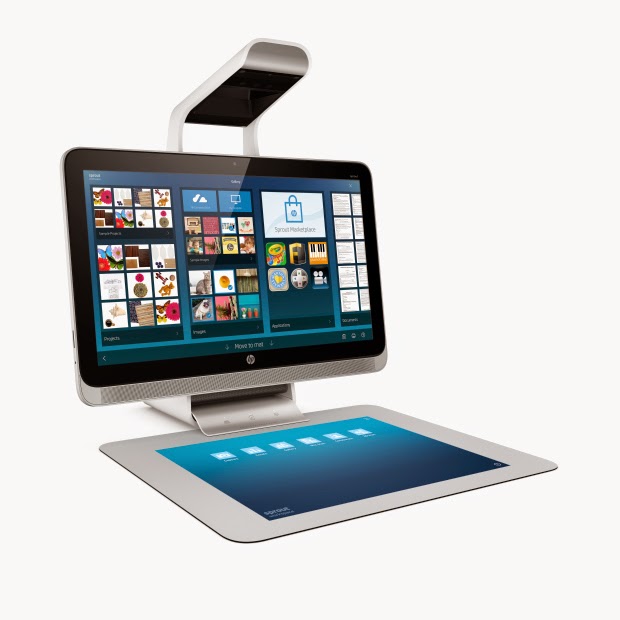We got to check out the new machine at CES 2015 in Las Vegas, in HP’s private suite in the Nobu hotel (located within Caesar’s Palace). The apparatus has three main components: a 23-inch monitor that has touchscreen capabilities, a touch mat that clips horizontally to the screen’s base, and an arm that extends out over the monitor, projecting a second screen onto the touch mat and tracking/scanning items placed on it with an impressive array of sensors and cameras.
Sprout’s creator, Brad Short, was on hand to give a run-through of its backstory and show us the ins and outs of how it functions: Images can be moved from screen to screen, allowing you to scan an item on the touch mat (either as a photo, or as a 3D file), and instantly utilize it in your current design document. Designs can also be shared with other Sprout computers or any other Windows PC with a “collaborate” function, allowing multiple people work on a creative project while in various separate locales.
The machine runs Windows 8.1, and like a normal computer the demo units all had keyboards and mice. But in the demos we saw, they were pushed off to the side and almost never used — the main point of Sprout is its hands-on (literally) immersive environment where the space between physical and digital shrinks to as tight of an integration as I’ve yet seen.
This interactive aspect really shined in the demos the HP team had on hand. The first one came from designer Colin Trentnor, who brought a batch of colored construction paper, X-acto knives, metal rulers, and plastic design templates — traditional, physical design tools. He used them to cut shapes, and then quickly scan them into Sprout (it will distinguish and separate various, individual items placed on the work mat) and then digitally assembled the textured, colorful shapes into a virtual Polaroid-themed collage image of a house with green grass and blue sky. The piece had the kitschy style but professional touch of an illustration a magazine would pay a lot of money to commission. Although he had only used the machine a few times before, he banged out his piece in just a couple of hours.
The other designer, Kiersten Stevens, used Sprout to explore ways to amplify her flower-themed creative pieces. She had a bag of various flowers, which despite being three-dimensional, reproduced cleanly and rapidly into the workspace. She then linked together the floral images to create typefaces. She explained that the digital creations she was working on mimicked the physical work she does professionally, but this allowed it to be done cleaner and quicker. She, like Colin, had only just started using it.
One of the most interesting demonstrations came from John-Mark Collins from development firm Ideum, who had built a couple of demonstration apps using the Sprout SDK. One of Ideum’s endeavors is creating interactive displays for museums. His first app was a paper-folding interface that displayed the steps on the main screen, while projecting a layout onto the work mat that showed you exactly where to place your paper and which folds to make for each step, resulting in a paper airplane or simple origami boat. It had a glossy, professional look to it — and it was built in just a couple of weeks.
His other app allowed you to scan your folded paper boats (or anything else you wished) and bring them into a screen-spanning virtual aquarium, where pushes and nudges on the items on the physical screen resulted in different actions.
Overall, it’s an interesting and unique tool. As it makes its way into the community (especially the maker community), there will undoubtedly be some creative and unexpected uses. The projector/sensor arm holds a ton of potential — there are advanced 3D sensors inside it that seemed to interface a lot more cleanly than many of the commercial 3D scanners do, for a start.
Sprout is available now. It retails for $1,899.

ليست هناك تعليقات:
إرسال تعليق